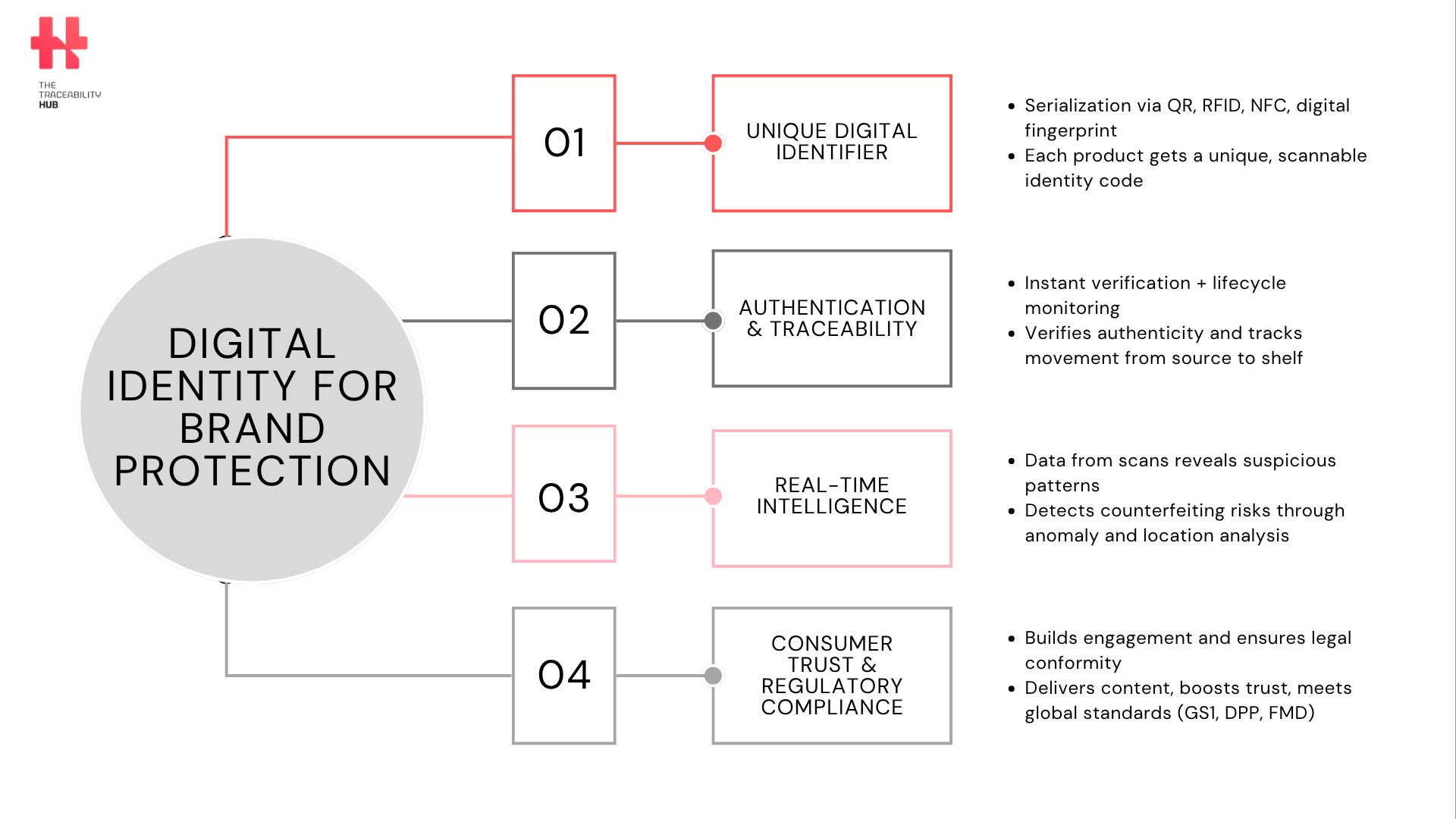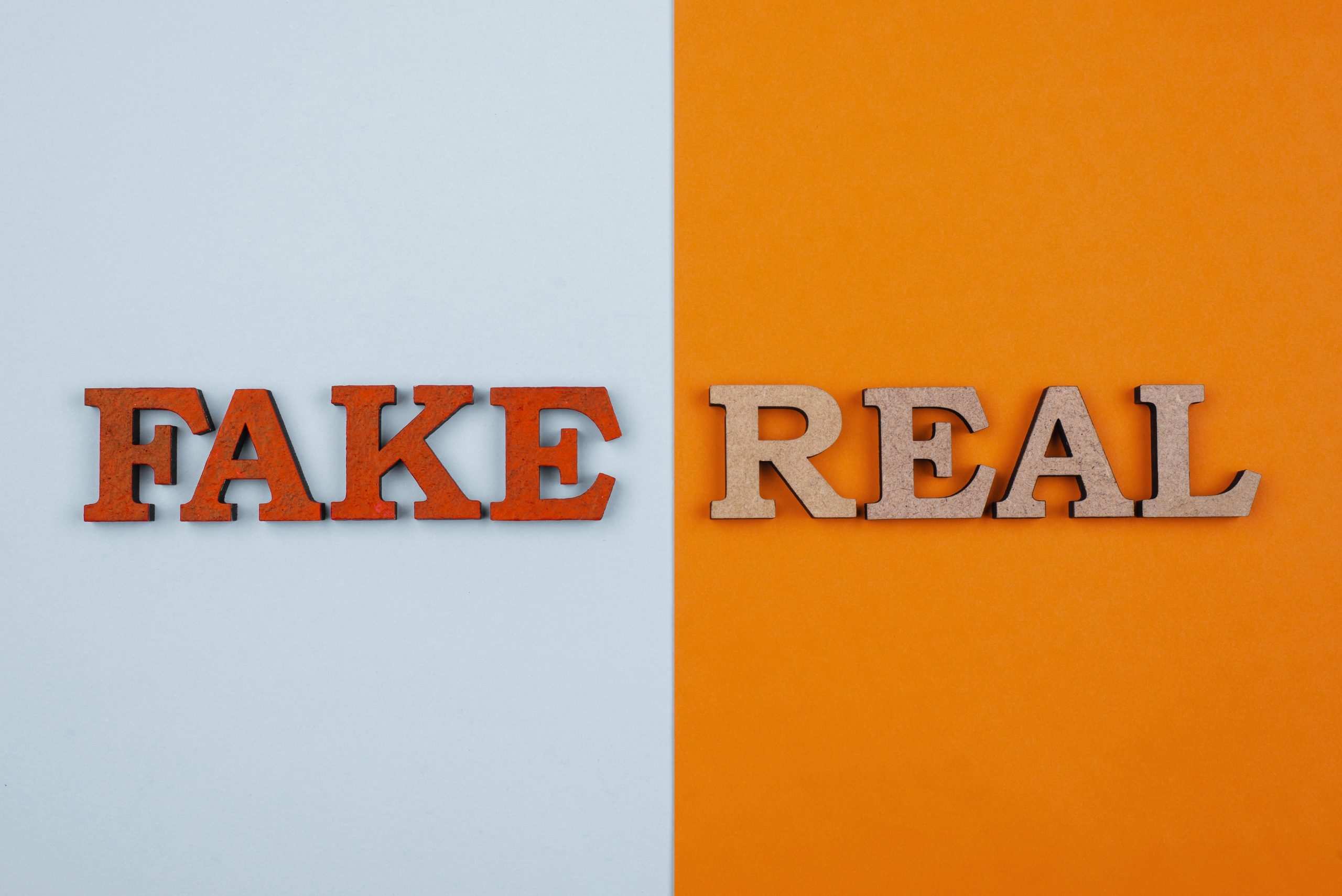Why Product digital identity Is Now Essential to Brand Protection
Brand protection has evolved dramatically in the digital age. Counterfeiting costs businesses over $323 billion annually worldwide and threatens profits, consumer safety and brand reputation. Traditional anti-counterfeiting methods can’t keep up with sophisticated forgery techniques anymore.
Product digital identity has then become the best tool for the modern anti-counterfeiting strategies. Companies can track items throughout their lifecycle and verify authenticity instantly by assigning unique digital identifiers to products. Digital tools that authenticate and trace products provide unprecedented visibility into supply chains. QR code product verification has expanded their role in brand protection from simple marketing links to powerful authentication gateways. Your brand’s protection from counterfeit products depends on understanding these digital solutions that combine product authentication with complete supply chain traceability.
This article explores how digital identity technologies reshape brand protection. You’ll learn the key implementation steps and understand the benefits and challenges of adopting these systems.
Understanding Product Digital Identity in Brand Protection
Product digital identity is now a fundamental transformation in how businesses protect their brands against counterfeiting. Traditional approaches that rely only on physical security features—like holograms or special inks—have created an unsustainable “race” between security innovators and counterfeiters who quickly adapt to defeat these measures. How does digital product identity protect brands? Digital identity provides a more resilient solution to this challenge.
Unique Identifiers and Serialization Explained
Product digital identities work as unique digital fingerprints assigned to individual products. These digital identities differ from traditional anti-counterfeiting methods by incorporating data that companies can verify and track throughout a product’s lifecycle. The process of assigning unique identification codes to each individual product unit—called serialization—serves as the foundation of this approach.
Serialization creates distinctive codes that function much like human fingerprints. Companies can apply these identifiers through various technologies including QR code product verification, RFID tags, NFC tag authentication, or digital fingerprint tagging. Brands use serialization techniques that give each product unique identifiers, which ensures authenticity and tracks inventory across global markets.
How Digital Identity Makes Authentication and Traceability Possible?
Brand protection digital identity becomes proactive rather than reactive with digital identity by making two critical capabilities possible: secure product authentication and traceability. Stakeholders—from customs officials to end consumers—can verify a product’s legitimacy instantly. Product visibility remains clear at every step from production to consumer.
Multiple layers of protection exist in practice. Companies monitor products throughout the supply chain and detect anomalies that might indicate counterfeit activity. Retailers verify incoming shipments easily. Consumers have the power to verify product authenticity before purchase or consumption.
On top of that, digital identities create valuable data with each interaction. Every scan of a QR code or NFC tag authentication records information such as location, time, and user patterns. This data helps identify potential counterfeit hotspots or unauthorized distribution channels. Unexpected clusters of verification attempt in regions without official distribution might signal counterfeit activity.
The move toward digital identity shows progress from the “whack-a-mole” approach of chasing counterfeiters to an evidence-based strategy that prevents problems before they occur. Digital identities act as both shield and radar for brand protection efforts—they defend products while gathering information about potential threats.
Digital Identity for Brand Protection

Core Technologies Powering Digital Brand Protection
Modern brand protection systems rely on several connected technologies. These product authentication solutions work together to create a reliable defense against counterfeiters who keep adapting their methods.
QR Codes and GS1 digital link brand protection Integration
QR code product verification has grown beyond simple marketing tools and now serves as powerful authentication gateways. GS1 digital link brand protection integration helps these codes link physical products to their digital identities. The wine industry shows excellent examples of implementation.
In Europe, nutritional information and ingredients are mandatory on wine bottles and an electronic label must be added. First of all, the list of ingredients and the nutritional declaration, as well as caloric value and allergens. If a QR code is used on the label, the words “Contains sulphites” must also appear. The rules on wine labeling were introduced by European Union Regulation number 2021/2117, of the European Parliament and of the Council, which came into force on 8 March 2024.
Penfolds uses QR codes to show provenance information, while Martell offers authentication services. Château Margaux shares details about their vintages. These codes serve two purposes: they confirm authenticity and help customers participate through storytelling. A quick scan confirms legitimacy and delivers rich product information. This authentication technology creates an unmatched experience that connects protection with marketing.
RFID and NFC tag authentication for Physical-Digital Bridging
Radio Frequency Identification (RFID) and Near Field Communication (NFC) tags create a direct link between physical items and their digital profiles. Luxury brands benefit greatly from these technologies. Burberry employs NFC tag authentication chips with blockchain-based tagging that lets customers quickly confirm authenticity. LVMH uses similar technology to connect consumers with exclusive brand experiences after verification. These physical tags are valuable in secondary markets where fake products often expand. They can show a product’s complete history—from materials and manufacturing details to purchase records.
Blockchain product identity for Immutable Supply Chain Records
When required blockchain technology offers unchangeable, transparent records of a product’s path. Information recorded on a blockchain stays permanent and creates an unbroken chain of custody. This fake product detection proves essential in many industries, especially pharmaceuticals where counterfeit drugs create serious safety risks. Blockchain product identity systems enable detailed tracking throughout a drug’s lifecycle and support compliance with regulations like the EU’s Falsified Medicines Directive.
AI for brand protection and Machine Learning for Counterfeit Detection
Artificial intelligence changes brand protection from reactive to proactive defense. AI systems analyze patterns in product interactions and flag suspicious activities like unexpected verification attempts in unauthorized regions. Machine learning algorithms get better continuously and identify fake product indicators that human inspectors might miss. These brand security technologies help brands predict potential threats instead of just responding to found counterfeits. This moves the approach to strategy based on applicable information.
Best tools for brand protection to Implement a Digital Identity System
Digital identity system implementation needs careful planning and execution. Organizations must carefully guide their transition from traditional anti-counterfeiting methods to digital identity solutions through several strategic steps.
Assessing Legacy Systems and Integration Needs
Your existing infrastructure evaluation stands as the primary challenge in digital identity implementation. Legacy systems operated by manufacturers need complex integration with modern digital technologies. A detailed analysis of current production processes should happen before moving forward because these processes might need restructuring to add digital identity features. Production lines often require optimization to add steps like marking products with unique identifiers that might not line up with current workflows.
Choosing the Right Data Platform for Identity Management
The right data platform selection is essential for a successful implementation. Your ideal platform should confirm product authenticity whatever the verifier’s role—field inspectors, wholesalers, retailers, legal counsel, or customs officers. Your platform should standardize digital identity deployment and management in line with global standards like GS1 digital link brand protection. This standardization minimizes complexity across different markets.
Training Teams and Educating Consumers
Internal teams need detailed training on new technologies to use digital identity benefits effectively. Consumer education becomes equally significant. Many organizations see interest drop when consumer interaction doesn’t meet expectations. Digital identity implementation becomes a transformative trip rather than a quick fix.
Ensuring Data Security and Regulatory Compliance
Digital identity systems gather substantial data about products and supply chains. Resilient security measures become vital, especially when you have decentralized operations. Organizations must keep up with emerging regulations. The EU’s Digital Product Passport requirements, taking effect in 2026, serve as a prime example. These product authentication solutions will require unique product identification with verifiable supply chain data that makes standardized approaches to digital identity management increasingly important.
Strategic investment, stakeholder buy-in, and collaborative effort drive the implementation process. Systematic solutions to challenges unlock digital identity’s full potential.
Benefits and Challenges of Going Digital
Digital brand protection’s move to digital systems brings both advantages and challenges that organizations must handle. Brand protection solutions switching from traditional security features to detailed digital identity systems face notable opportunities and obstacles worth looking into.
Improved Consumer trust digital identity and Engagement
Digital identities create stronger bonds between brands and consumers. Verify product authenticity enables customers to verify product legitimacy right away, which reduces purchase hesitation. Each scan provides verification plus valuable content such as product stories, recipes, loyalty programs, eco-friendly and quality methods, as well as usage tips. Wine brands show this dual benefit as well. Martell uses QR code product verification for authentication while Johnnie Walker provides interactive experiences through the same technology. These interactions generate valuable data like geographical location, interaction frequency, and consumer demographics that help strengthen brand protection efforts.
Real-Time Supply Chain Visibility
Digital identity systems have changed supply chain management from occasional checks to non-stop monitoring. Traceability and brand protection technologies track goods throughout their movement—starting from raw material sourcing through production to downstream distribution. Supply chain visibility helps detect suspicious patterns or unexpected verification attempts that could signal counterfeit activity. This intelligence-based strategy lets brands spot issues before they grow, which changes the approach to preventive measures.
Cost and Complexity of Implementation
Digital identities need substantial investment. Hardware acquisition costs include Vision Systems, AutoID, IoT for brand protection, software licenses, implementation services, and ongoing training. Legacy system integration creates technical challenges that often require production line changes. Manufacturers need viable business cases with stakeholder support since promising initiatives often fail without proper planning and executive backing.
Varying Global Regulatory Requirements
Region-specific regulations create mounting challenges. The upcoming EU Digital Product Passport requirements (effective 2026) will need unique identifiers with certifiable supply chain data for certain products. Current pharmaceutical regulations like the EU’s Falsified Medicines Directive highlight the need for standardized approaches to digital identity management that follow global standards such as GS1 digital link brand protection.
The Future of Trusted Brand Protection
Digital identity has revolutionized brand protection strategies in the fight against sophisticated counterfeiting operations. This article explores how unique digital identifiers protect products and gather information about potential threats.
Brand protection’s future lies in digital solutions without doubt. QR code product verification has grown from simple marketing tools into powerful authentication gateways. RFID and NFC tag authentication technologies connect physical products with their digital profiles, while, if necessary, blockchain creates unchangeable supply chain records. AI and machine learning help companies predict threats before they materialize.
Organizations implementing these systems encounter several challenges. Teams must evaluate existing systems, pick suitable data platforms, train staff, and help consumers understand the process. The initial costs and complexity might seem overwhelming. The benefits surpass these obstacles by a wide margin. Live supply chain visibility helps brands identify issues early. Customer trust improves as people verify authenticity instantly.
Digital identity creates an ongoing process of improvement. The regulatory landscape continues to develop, particularly with new requirements like the EU Digital passport for products. Early adopters will definitely gain a competitive edge through better protection and stronger customer relationships.
The move from traditional anti-counterfeiting technology to complete digital identity systems shows a vital development in brand integrity protection and in consumers’ awareness. Companies that embrace these technologies are now preparing for a future where authentic products receive instant verification, tracking, and trust. This creates stronger brands that customers support with confidence.
Read more: The New Frontier of Fraud: How Return Scams Are Threatening Luxury Marketplaces






